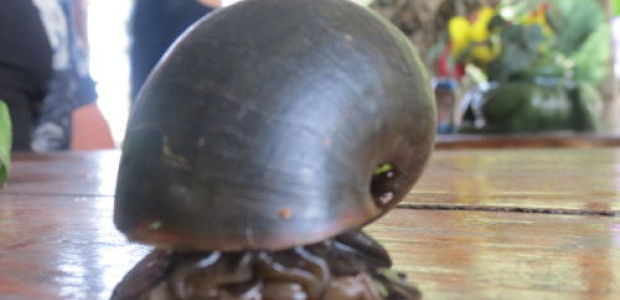
Ryan bringing energy, passion to Saints’ D
August 20, 20136 vie for NSU’s top spot
August 20, 2013Rolling thunder teased a distant storm’s approach, as Ralph Usea guided the Zam’s Swamp Tours pontoon boat through moss-canopied black-green waters, eyes on the lookout for alligators and turtles.
For Mr. Ralph, who has lived on Bayou Boeuf for all of his 77 years, the meandering brackish water body holds few secrets and fewer surprises.
But on this Wednesday afternoon tour, as a group of engineering students from France spoke their native tongue and struggled to comprehend Mr. Ralph’s bayou French, there came a question he couldn’t answer.
They expressed keen curiosity about flecks of pink visible on the trunks and knees of the cypress trees lining the great swamp, like so many hunks of bubble gum left by an incomprehensible number of inconsiderate children.
“I don’t know what that is,” said Mr. Ralph. “We are seeing that for the first time here.”
Within a few days an answer was obtained.
The pink, slimy clusters are the eggs of an invasive snail species naturalists say pose a huge threat to this bayou and other mostly fresh-water bodies.
Scientists said this is the first time eggs of the fist-sized apple snail have been documented in Lafourche Parish. Already seen in Terrebonne, the large, non-native invaders could pose a future threat to Louisiana’s rice crop, as well as other resources.
The apple snail was first spotted in Louisiana around 2007, said Kerry St. Pe of the Barartaria -Terrebonne Natural Estuary Program, and they represent a substantial menace.
“We first saw them in Plaqumines Parish,” St. Pe said. “Then last year they started appearing in Donner and Chacahoula.”
Scientists are trying to develop ways to kill the snails that won’t kill other bayou life. But the snails are multiplying faster than solutions will come.
“They are a group of freshwater aquatic snails, mostly from South America,” said Michael Massimi, BTNEP’s Invasive Species Coordinator. “They were transported to lots of different spots in southeast Asia as a human food source, but escaped cultivation and wreaked havoc on the rice industry. They are a serious rice crop pest in the Philippines and Vietnam and Indonesia. They were introduced here for the aquarium trade. Walmart was selling them for a long time.”
In local waters – where there is no rice – the snails pose a threat to aquatic plants beneath the surface, which are hiding places for fish that sportsmen prize. Once denuded of that underwater cover, the affected water bodies will be less attractive places for finfish to live and breed, Massimi said.
The aquarium trade is no longer allowed to traffic in apple snails, Massimi said. But the threat is taking a big foothold.
“They eat vegetation and a lot of it,” Massimi said, noting that while loathed invasive plants like water hyacinths make perfectly good food for apple snails, they should not be considered as a tool for fighting that particular invasion.
“Using them for weed control would be horribly misguided,” Massimi said. “We are seeing a range expansion, with what appear to be multiple releases. The range includes Schriever from the borrow ditch at La. 20 and west toward Morgan City. There are confirmations of apple snails across the guide levee from the Terrebonne Basin to the Atchafalaya Basin.”
LSU AGCenter scientists, Massimi said, are keenly aware of the problem, and are beginning contact with rice industry leaders in south-central Louisiana.
Areas that will likely not be affected are the extreme southern coastal communities, where the salt content of water is too high to accommodate the snails.
A habitat like that along Bayou Boeuf, scientists agree, is perfect for the creatures.
The snails mate in the water, and the female snails crawl patiently – often with great difficulty – up the trunks of trees or along cypress knees. Once they have reached a height they deem suitable they discharge the pink egg sacs, each of which holds in excess of 200 eggs.
The sacks turn lighter, eventually almost white, as they mature, and the newly hatched snails drop into the water below.
Some are lost to predation – many creatures that inhabit the swamps find any kind of snail to be a tasty treat – but as has become obvious in the waters of Bayou Boeuf, enough remain to make a sizable notice of appearance as new eggs are laid.
One problem with the snails, Massima said, is their ability to lay multiple egg clusters over periods of months.
“They have a very high survivorship,” Massima said.
People spotting the egg sacs should feel free to crush them if they wish, Massima said. It is not recommended that they or adult apple snails be transported from place to place, as that could result in increased spread of the range.
Appearing as they have in Cajun country, where culinary imagination has made a gourmet dish out of a creature as seemingly undeserving as the nutria, gives scientists some hope that commercial markets for the critters might reduce populations.
The snails are edible and can be used in a gumbo, Massima said. But they must be very thoroughly cooked because, being freshwater creatures, they can harbor parasites and bacteria harmful to humans.
The snails were a topic of discussion at the swamp tour Saturday, as guests watched a grown specimen make its way – quite rapidly – across an outdoor table top.
Zamariah Loupe, whose parents run the operation, said he has neaux fear when it comes to apple snails.
“I saw some of the eggs fall the other day,” the 17-year-old bayou boy said. “All the minnows went crazy, all of them eating the eggs. I’m hoping the minnows can get them all.”
This grown apple snail was plucked out of Bayou Boeuf in northern Lafourche Parish. Apple snails were first spotted in Louisiana in 2007, according to Kerry St. Pe of the Barataria-Terrebonne Natural Estuary Program. The invasive snails post a huge threat to mostly fresh-water bodies.










